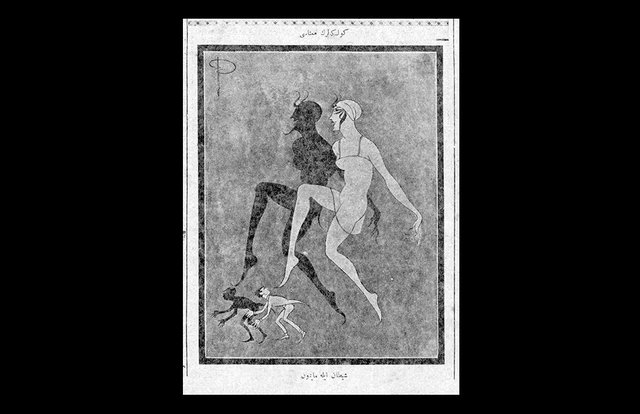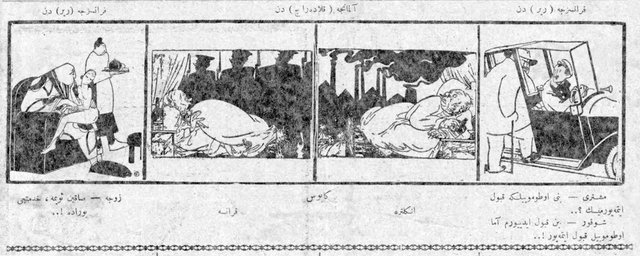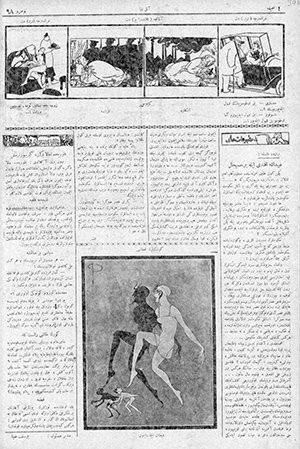122. Today in 1920s Turkey: 12 November 1923 (What the Shadows Convey)

(Cartoon by Ramiz, Akbaba or “Vulture/White-Bearded Old Man,” 12 November 1923, no. 98, page. 4)
Türkçe:
(Üstte) Gölgelerin Manası
(Altta) Şeytan ile maymun
English:
(Above) The Meaning of Shadows
(Below) Devil and monkey
Comments
This cartoon more or less constitutes an artist’s exercise in shadow play. On the one hand there is a representation of “reality” and on the other is the shadow it casts upon the vertical wall behind it. The “real” scene consists of a giant, lanky woman merrily stomping upon a miniature man who is attempting to scamper away. Details from the woman’s physiology are translated to a single-tone shadow revealing her true nature to be that of a cruel, devilish fiend. Likewise, the miniature man’s shadow reveals him to be a helpless monkey at the mercy of the devil. Thus, according to artist Ramiz’s clever illustration, the devil-monkey relationship is analogous to the dynamics of a female-male courtship affair gone sour.
This is not the first cartoon by Ramiz that includes a clever visual trick. Other similar examples covered by Today in 1920s Turkey include posts #59 and #61. This cartoon fits into the Today in 1920s Turkey archives in another way as it hails from the same issue as the cartoons discussed in last year’s edition of Today. In this way, post #122 and #31 are connected. Post #31 considered two related cartoons by an unknown artist located on pages 2 and 3. The two Turkish cartoons were thematically inspired by a foreign cartoon republished on page 4 of the same issue as all three happened riff off the same “nightmare” trope. Surprisingly, the current Demon vs. Monkey cartoon by Ramiz also seems to be inspired partially by the same foreign cartoon but in a different way. This inspirational foreign cartoon is located below.

(German cartoon, Akbaba, 12 November 1923, no. 98, page 4.)
The specific cartoon in question is the two-frame sequence in the center of the strip. Text below the cartoons identifies the scene as "nightmare" (kabus) and the right frame as "England" (Ingiltere) and the left as "France" (Fransa). Both countries are disturbed by their respective nightmares projected into their bedrooms as shape-shifting shadows. In fact, both Ramiz’s cartoon and the foreign cartoon occupy page 4 of the same issue of Akbaba (see below full-page image). While the subject matter of the two cartoons is quite different, their employment of shadows to play visual tricks on an unsuspecting audience are similar. The fact that the foreign cartoon that triggered so many creative offshoots is included in the same issue as its conceptual “progeny” indicates that at times the cartoonists were not afraid to expose their references to their audience. In a sense, all of the related images create a sort of visual puzzle for the reader to piece together—something that reveals the very processes behind creating content for the satirical journal.

(Entire page, Akbaba, 12 November 1923, no. 98, page 4.)
Tarih 1923 yılı, ilginc.
Mizah da bile eski alfabemizin daha güzel olduğunu görmek üzüyor. Keşke onu da öğrenebilseydik okullarımızda.
Sonradan öğrenmek de mümkün! It’s never too late, yani.